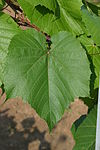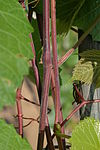Börner (document type)
| Borner | |
|---|---|
| Synonyms | Börnerrebe |
| Breeding number | Na 5153-54 |

|
|
| Art | Interspecific crossing |
| use | |
| origin | Germany |
| breeder | Carl Borner |
| VIVC no. | 1499 |
| ancestry | |
|
Hybrid from |
|
| List of grape varieties | |
Börner is a vine rootstock bred by Carl Julius Bernhard Börner for the biotechnical control of root aphid, especially on soils contaminated with phylloxera . It is the first phylloxera-resistant rootstock.
ancestry
The variety Börner is a cross by Carl Julius Bernhard Börner from Germany of Vitis riparia 183 Gm with Vitis cinerea .
In 1943 the seedling Naumburg Na 5153-54 was planted together with another 145 descendants of the cross in the soil test gardens in Zell of the State Teaching and Research Institute for Agriculture, Viticulture and Horticulture (LLFA Neustadt / Weinstrasse) in the Palatinate . Only after the end of the Second World War was the population of Becker and Brückbauer selected and the best types further tested and increased. Helmut Becker continued the exams at the Geisenheim research institute in 1964 . After extensive trials in various wine-growing regions , the first phylloxera-resistant rootstock variety was registered for plant variety protection under the name Börner in 1982 in honor of the breeder. Since 1989 the institute for grapevine breeding and refinement of the research institute Geisenheim is registered as a systematic maintenance breeder of the stock variety Börner with the clone 1 Gm in the variety list.
Ampelographic features
The Börner variety is a climbing shrub . The shoot axes are angular, striped wine-red to wine-red and short bristly hairy. The tip of the shoot is open, yellow-brownish-green, coated with whitish, rimmed with carmine-red and densely woolly hairs. The three-part tendrils are wine red with individual wool hairs .
The alternate leaves are arranged in a petiole and a leaf blade. In young leaves, the middle lobes of the leaf blades have long tips and are yellow-brownish-green, slightly vesicular, shiny, cobweby on the upper side, densely bristly hairy on the underside with yellow-green, dense, short-bristled leaf veins . In the relatively large fully grown leaf, the dark green leaf blade is broadly wedge-shaped to heart-shaped, weakly three-lobed with weakly pronounced bays and a u- to lyra -shaped stalk bay; the upper surface of the leaves is dark, slightly shiny. The base leaves are overlapping.
From an ecological point of view, it is a male pseudo-hermaphrodite with usually six anthers .
Shoot axes with bark
Properties - use
The stock grape Börner gives the noble variety a medium to strong growth. The roots watch half-deep. Due to necrotic reactions after being bitten by the aphid , they cannot form galls and thus cannot multiply above ground. The phylloxera immunity to root phylloxera is very beneficial . It is also partially resistant to nematode infestation, which means that viruses are only rarely transmitted. The compatibility with edible veins (varieties) and the adaptation to the soil is good. It has only a medium tolerance to lime , has good resistance to winter frost and good drought resistance . When waterlogged in spring, it shows chlorosis .
Because of its phylloxera immunity, Börner can also be planted on soil that is heavily contaminated with phylloxera. It is unsuitable for lime-rich , compact, difficult-to-heat and wet soils. In these cases she gets severe chlorosis. Well-suited for this underlay are deep soils that are easy to heat, rich in skeletons , prone to drought.
literature
- Joachim Schmid, Frank Manty, Bettina Lindner: Geisenheimer grape varieties and clones (= Geisenheimer reports. 67). Geisenheim Research Institute - Department of Vine Breeding and Refinement, Geisenheim 2009, ISBN 978-3-934742-56-7 .
- Karl Bauer, Ferdinand Regner , Barbara Schildberger: Viticulture (= AV book. ). 9th, updated edition. Cadmos, Vienna 2013, ISBN 978-3-7040-2284-4 .
Individual evidence
- ↑ Joachim Schmid, Frank Manty, Bettina Lindner: Geisenheimer grape varieties and clones. 2009.
- ↑ a b c d e f Geisenheim Research Institute, Department of Vine Breeding and Grafting ( Memento of the original from January 4, 2015 in the Internet Archive ) Info: The archive link was inserted automatically and has not yet been checked. Please check the original and archive link according to the instructions and then remove this notice. (PDF; 153 kB)



